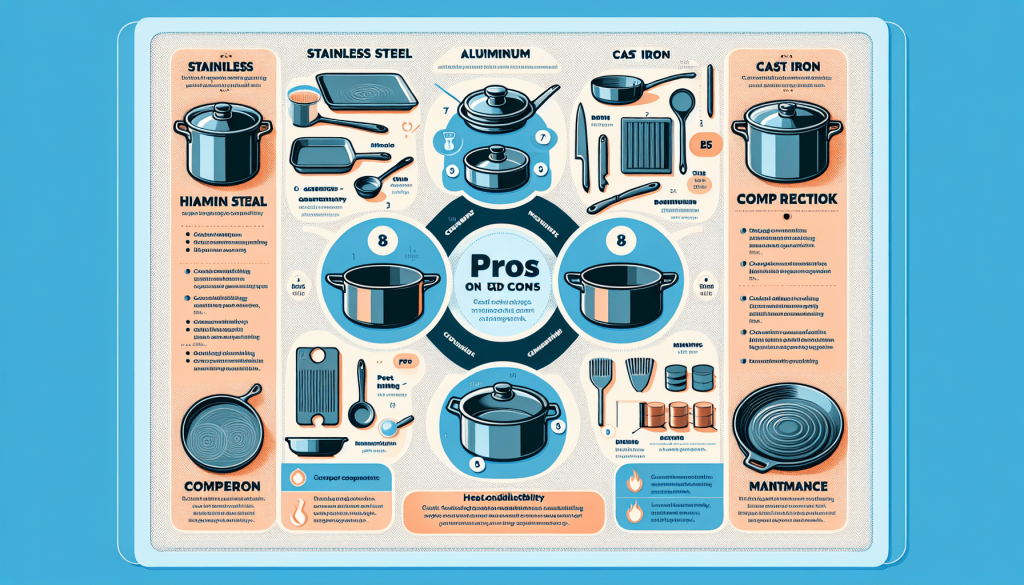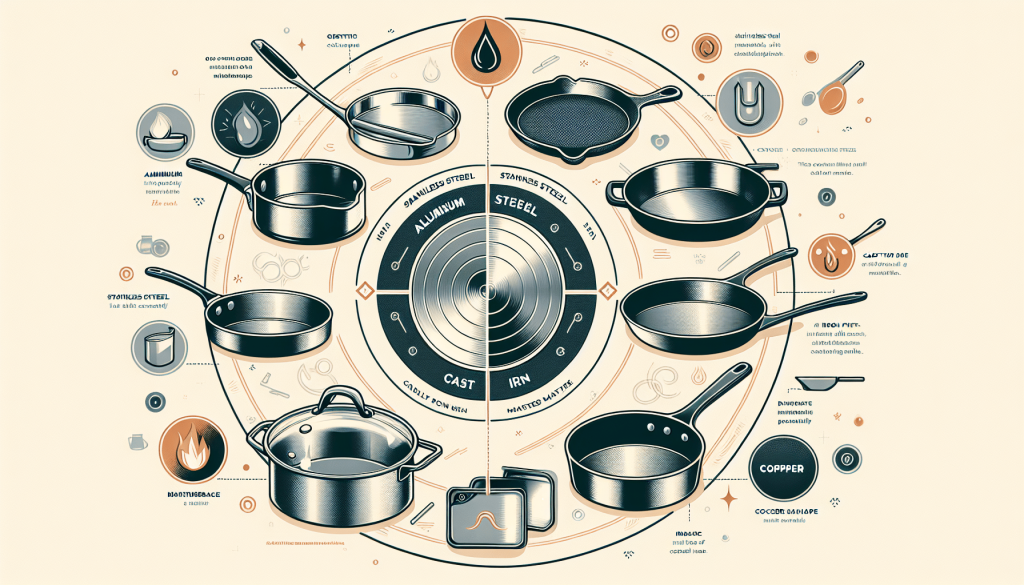If you’re a cooking enthusiast or someone who enjoys spending time in the kitchen, then understanding the various cookware materials and their construction is essential. From stainless steel to cast iron, non-stick coatings to copper, each type of cookware has its advantages and disadvantages. In this detailed guide, we will explore the different materials used in cookware and provide insights into their construction, helping you make informed decisions when it comes to choosing the right pots and pans for your culinary adventures.

Introduction
Welcome to the ultimate guide to cookware materials and construction! In this comprehensive article, we will delve into the world of cookware, exploring various materials and construction techniques. We will discuss the benefits and drawbacks of different options, compare popular materials, and provide tips on choosing the right cookware for your needs. Additionally, we will cover proper handling, care, and alternative options. So, whether you’re a seasoned chef or a novice cook, this guide is here to help you make informed decisions and enhance your cooking experience.
1. Understanding Cookware Materials
Cookware materials play a crucial role in determining the performance and durability of your pots and pans. Let’s take a closer look at some commonly used materials:
1.1 Stainless Steel
Stainless steel is a popular choice for cookware due to its durability and resistance to corrosion. It is known for its sleek appearance and ability to maintain its finish even with regular use. However, stainless steel alone can have poor heat distribution properties, which is why it is often combined with other materials in clad cookware.
1.2 Cast Iron
Cast iron cookware is renowned for its excellent heat retention and even heat distribution. It can withstand high temperatures, making it suitable for a variety of cooking methods, including searing and slow cooking. Cast iron requires special maintenance, such as seasoning, to prevent rust and maintain its non-stick properties.
1.3 Non-Stick Coatings
Non-stick coatings have revolutionized the cooking industry by making it easier to cook with less oil and prevent food from sticking to the surface. These coatings are often applied to aluminum or stainless steel pans. While non-stick cookware is convenient, it may not be as durable as other materials and requires gentle handling and proper care.
1.4 Copper
Copper cookware is prized for its exceptional heat conductivity, allowing for precise temperature control during cooking. It heats up and cools down rapidly, making it ideal for delicate recipes. However, copper can react with certain foods, leading to off-flavors or discoloration. Consequently, most copper cookware is lined with stainless steel or tin to mitigate these concerns.
1.5 Aluminium
Aluminum cookware is lightweight, affordable, and has excellent heat conductivity. It heats up quickly and distributes heat evenly. However, pure aluminum can react with acidic ingredients, altering the taste of the food. To address this, most aluminum cookware is now coated with non-reactive materials or anodized to prevent such reactions.
2. Evaluating Cookware Construction
Apart from the material used, the construction of cookware also affects its performance and longevity. Let’s explore some key aspects of cookware construction:
2.1 Clad Cookware
Clad cookware, also known as multi-ply or tri-ply cookware, consists of multiple layers of different materials sandwiched together. This construction allows for better heat distribution and retention compared to cookware with a single layer. Clad cookware often features a core layer of aluminum or copper, sandwiched between layers of stainless steel, providing the benefits of both materials.
2.2 Single Layer Cookware
Single layer cookware, on the other hand, is made from a single material without additional layers. While it may lack the superior heat distribution of clad cookware, single layer pots and pans are often more affordable and suitable for basic cooking needs.
2.3 Bottom Thickness
The thickness of the cookware’s bottom is an important factor to consider. Thicker bottoms generally offer better heat distribution and retention. They also provide more durability and resistance to warping. However, thicker cookware can take longer to heat up than thinner options.
2.4 Rivets and Handles
The quality of the handles and rivets can significantly impact the performance and durability of cookware. Sturdy rivets ensure that handles are securely attached, preventing accidents during use. Heat-resistant handles are also desirable to provide added safety and convenience.
3. Benefits and Drawbacks
Now that we understand the different cookware materials and construction techniques, let’s explore their benefits and drawbacks:
3.1 Heat Distribution
Good heat distribution is essential for even cooking and preventing hotspots. Materials like copper and aluminum excel in this area, while others, like stainless steel, may benefit from clad construction to enhance heat distribution.
3.2 Durability
The durability of cookware depends on the material and construction. Cast iron is especially renowned for its longevity, while stainless steel provides excellent resistance to corrosion. Non-stick coatings may wear off over time, requiring replacement or careful maintenance to extend their lifespan.
3.3 Heat Retention
Heat retention refers to how well cookware holds heat after being removed from the heat source. Cast iron and clad cookware typically excel in this area, allowing for longer cooking times without constant heat application.
3.4 Maintenance
Different materials require different maintenance routines. Cast iron needs to be seasoned regularly, while non-stick cookware requires gentle cleaning to avoid scratches. Stainless steel and copper may require specific cleaning techniques to maintain their shine.

4. Common Cookware Materials Comparison
Let’s compare stainless steel with some other popular cookware materials to help you understand their differences and decide which suits your needs best:
4.1 Stainless Steel vs. Cast Iron
Stainless steel offers durability and ease of maintenance, while cast iron excels in heat retention and even heat distribution. Stainless steel is more versatile and often used for a wide range of cooking tasks, while cast iron is best known for its ability to achieve a deep sear and slow cook. Consider your cooking preferences and maintenance routine when choosing between the two.
4.2 Stainless Steel vs. Non-Stick
Stainless steel and non-stick cookware serve different purposes. Stainless steel is ideal for browning, deglazing, and achieving a beautiful fond, while non-stick cookware is perfect for low-fat cooking and easily releasing delicate foods. If you can afford it, having a combination of both can provide you with the best of both worlds.
4.3 Stainless Steel vs. Copper
Stainless steel offers durability and ease of maintenance, whereas copper provides excellent heat conductivity. Clad cookware combines the benefits of both materials, making it a popular choice for professional chefs and cooking enthusiasts. Consider your cooking style, budget, and desired heat performance when making a decision between stainless steel and copper.
4.4 Stainless Steel vs. Aluminium
Stainless steel and aluminum have different heat conductivity properties. While aluminum heats up quickly and evenly, stainless steel benefits from its durability and versatility. Clad cookware with an aluminum core provides a balance between heat distribution and longevity. Again, consider your cooking needs and budget when selecting between stainless steel and aluminum.
5. Choosing the Right Cookware
Choosing the right cookware involves considering factors such as cooking style, budget, compatibility with cooktops, and cleaning needs. Let’s explore these considerations further:
5.1 Consider Your Cooking Style
Think about the type of cooking you most frequently engage in. Are you a sautéing expert, a baking aficionado, or an adventurous home chef trying out new recipes? Different cooking techniques may require specific materials or constructions. Consider your favorite recipes and cooking methods to guide your choice.
5.2 Budget and Longevity
Sometimes budget constraints come into play when choosing cookware. While premium options may offer superior performance and longevity, there are also affordable alternatives available. Striking a balance between budget and quality will help you find the best cookware for your needs.
5.3 Compatibility with Cooktops
Not all cookware materials are suitable for all cooktops. For example, induction cooktops require magnetic materials like stainless steel or cast iron. Ensure your cookware is compatible with your cooktop to avoid frustration and inefficient cooking.
5.4 Cleaning and Maintenance
Consider your cleaning and maintenance preferences when selecting cookware. Some materials require specific care routines, while others are more forgiving. If you prefer minimal maintenance, non-stick cookware or stainless steel with a non-stick coating may be the way to go.
6. Proper Handling and Care
Proper handling and care of cookware are essential for maintaining its performance and longevity. Let’s explore some important tips:
6.1 Preparing Cookware Before Use
Before using new cookware, it’s essential to clean it thoroughly to remove any manufacturing residues. Follow manufacturer instructions for any specific pre-use preparations. Seasoning cast iron, when required, will enhance its non-stick properties and protect it from rust.
6.2 Cooking Techniques and Heat
Different cookware materials and construction can tolerate different heat levels and cooking techniques. Refer to the manufacturer’s instructions for guidance on heat limits and suitable cooking methods. Avoid subjecting non-stick cookware to high heat or using metal utensils that can scratch the surface.
6.3 Cleaning and Maintenance Tips
Proper cleaning and maintenance are vital to ensure the longevity of your cookware. Avoid harsh abrasives when cleaning, and opt for gentle dishwashing detergents. For materials that require special cleaning, follow the manufacturer’s instructions to maintain their quality.
7. Alternative Cookware Options
Apart from the commonly discussed cookware materials, there are a few alternative options worth considering:
7.1 Carbon Steel
Carbon steel cookware is similar to cast iron but lighter and more responsive to heat. It develops a natural non-stick surface over time and requires seasoning. Carbon steel is frequently used in professional kitchens and is perfect for high-heat cooking techniques.
7.2 Enamel Coated Cookware
Enamel-coated cookware features a layer of enamel over cast iron or steel, providing a non-reactive cooking surface. It is easy to clean and adds a pop of color to your kitchen. However, enamel coatings can chip, compromising the cookware’s performance and aesthetics.
7.3 Clay and Stoneware
Clay and stoneware cookware have been used for centuries. They provide gentle, even heat distribution and are perfect for slow-cooked dishes and baking. However, they require special care as they can be fragile and susceptible to cracking if not used and cleaned properly.
8. Conclusion
Congratulations! You have successfully completed the ultimate guide to cookware materials and construction. Armed with knowledge about different materials, construction techniques, benefits, drawbacks, and alternative options, you are now ready to make informed decisions when purchasing new cookware.
Remember to consider your cooking style, budget, and cleaning preferences when choosing the right cookware for your kitchen. Proper handling, care, and maintenance will help extend the lifespan of your cookware, ensuring optimal performance.
Now, go forth and explore the exciting world of cookware, experiment with different materials, and elevate your cooking experience to new heights! Happy cooking!
